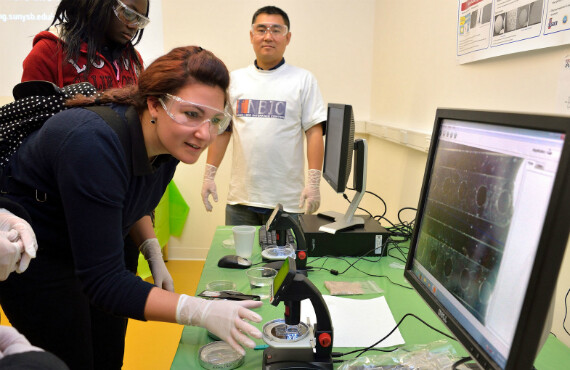Nano/Bio Interface Center Recognizes Student Achievements at Penn’s NanoDay 2015
By Niharika Gupta
Every year, the University of Pennsylvania’s Nano/Bio Interface Center sponsors a day of education and outreach programs highlighting Penn’s interdisciplinary nanotechnology research. Studying the unique properties of structures on the scale of atoms and molecules has led to advances in computer components, alternative energy technologies and many other applications.
At NanoDay@Penn, nanotech researchers show off their work and provide interactive demonstrations to local middle and high school students, host a high school science fair, give tours of the School of Engineering and Applied Science’s labs and present a keynote address from a leading figure in the field.
[flickr]https://www.flickr.com/photos/universityofpennsylvania/sets/72157658527…]
The event culminates with an award ceremony that recognizes Penn student achievements in research and creativity. The NBIC’s Graduate Research award recognizes academic achievement, while the Image Awards, presented in the categories of scientific, artistic and animation, go to students who have produced stimulating and remarkable views of nanoscale phenomena in the course of their research.
The 2015 Graduate Research Award went to Frank Streller, a graduate student in the Department of Materials Science and Engineering. A member of Robert Carpick’s research group in Engineering’s Department of Mechanical Engineering and Applied Mechanics, Strellar’s research interest is on nanoelectromechanical switches as a candidate to replace transistors due to their comparably lower power consumption.
This year’s Scientific Image Award went to Hai Zhu, a graduate student in Ertugrul Cubukcu’s lab in the Department of Materials Science and Engineering, for his scanning electron microscope image of 3D plasmonic nanoantenna arrays. The image, “Flower,” was formed after thin films, modified with nanoscale antenna arrays, curled up due to stress, forming a “microflower.”
The Artistic Award went to two members of Igor Bargatin’s lab: John Cortes, a mechanical engineering graduate student, and Keivan Davami, a mechanical engineering postdoc. Their submission was a colorized photograph of a “forest” of vertical graphene sheets, also known as carbon nanowalls, grown on copper substrate.
Martin Haase won the Animation Award for his video, “Solvent Transfer Induced Phase Separation in Action,” which shows porous polymer fibers extruding into long, sinuous tubes, which can function as channels for the transport of molecules. Haase is a postdoctoral researcher in the Department of Chemical and Biomolecular Engineering, working in Daeyeon Lee’s group.
[youtube]cl2sczwaOlo[/youtube]








